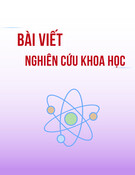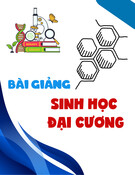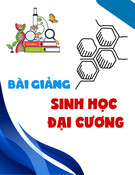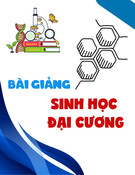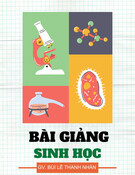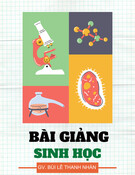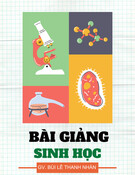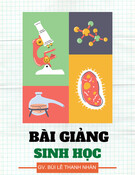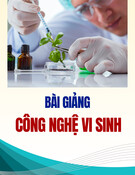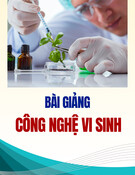89
Special Issue
JOURNAL OF SCIENCE AND TECHNOLOGY DONG NAI TECHNOLOGY UNIVERSITY
FABRICATION AND CHARACTERIZATION OF CHITOSAN- GELATIN COMPOSITE FILM
1Ho Chi Minh City University of Technology (HCMUT), VNU-HCM 2Deakin University *Corresponding author: Phung K Le, phungle@hcmut.edu.vn
Tuyen B. Ly1, Giang T.C. Tran1, Hoang Chinh Nguyen2, Phung K. Le1*
GENERAL INFORMATION
ABSTRACT
Received date: 25/03/2024
Revised date: 08/05/2024
Accepted date: 01/08/2024
KEYWORD
Biopackaging;
and
strength
lowered water
Chitosan;
Gelatin.
the
Recent research is focusing on the development of bio- packaging materials by mixing different polymers to enhance the bonding strength within the matrix and combining favorable properties of the constituent materials. This work developed a biopackaging material by combining chitosan, gelatin, and glycerol. The effect of the molecular weight of chitosan and the composition of the casting solution on the properties of the biopacking material was investigated. Increasing chitosan concentration resulted in an increased mechanical solubility. Thermogravimetric analysis and UV-vis spectroscopy analysis suggested that increasing gelatin concentration would allow for a more elastic packaging with higher transparency and better thermal stability. From this result, a thin (< 0.05 mm) biopackaging material with a mechanical strength of up to 17 N/mm2 with an allowed 30% elongation at break was attained. The smoother surface structure under scanning electron microscope and the variations in properties between samples were allocated to the inherent characteristics of chitosan and gelatin and the promotion of intermolecular bonding from the glycerol plasticizer. These results therefore not only develop a functional packaging material with multiple applications in food and healthcare, but also provide a deeper understanding on linking behavior of biopolymers.
1. INTRODUCTION
replacement of the combinations of biopolymer material with favorable properties are on the increase for suitable traditional plastics (Wang et al., 2024).
Following recent trends in sustainable development, increasing concerns regarding food safety has given rise to research for safe biodegradable packaging. Within this scope, Chitosan is a polymer product of chitin from waste deriving deacetylation,
JOURNAL OF SCIENCE AND TECHNOLOGY DONG NAI TECHNOLOGY UNIVERSITY
90
Special Issue
system were evaluated polymer for applications in food preservation (Figure 1).
and
focusing on industry, food
crustacean shells, which is gaining much interest due to favorable properties of low inherent toxicity, high biodegradability, antimicrobial high properties biocompatibility (Haghighi et al., 2020). The material is widely used in the pharmaceutical and the development of self-preserving packaging by utilizing its inherent antibacterial activity and unique characteristics. This gives rise to a wide variety of chitosan-containing products, including hydrogel beads, films, fibers, and biopackaging.
Figure 1. Model of the bonding mechanism between chitosan, gelatin and glycerol.
2. METHODOLOGY
2.1. Materials
Chitosan (C6H11O4N)n (CS) was provided by Vietnam Food Joint Stock Company, Ca Mau, Vietnam with deacetylation level >75%. Gelatin (GE) was purchased from a local vendor, which was food-grade gelatin powder used for baking. All other chemicals, including glycerol (C3H5(OH3)) and acetic acid (CH3COOH) were purchased and used directly without any modifications.
2.2. Synthesis of biopackaging material
The chitosan/gelatin
Chitosan can be combined with other polymers to improve its functionality (de Mesquita et al., 2012). Gelatin is a biological polymer prepared by naturally reducing collagen with heat. It comes in the form of a clear, colorless or pale-yellow powder and is almost tasteless. Gelatin can create clear and flexible polymer where, depending on the type of gelatin, it can undergo poly-ionic complexation with positively or negatively charged agents. Gelatin is very hydrophilic and has good gas barrier properties, making it valuable for tissue engineering application. However, its poor mechanical properties have limited its application as a packaging material, leading to promoted research to improve its mechanical properties (Yin et al., 2018).
biopackaging fabrication process was referenced from a previous process with suitable adjustment. CS was dissolved in 100 mL of acetic acid 1% by stirring at 60 ºC for 1 h to create a homogeneous chitosan solution. Four types of chitosan with different molecular weight were investigated, including low molecular weight (LW, 158 kDa, ≤150 cPs), medium molecular weight 1 (MW1, 272 kDa, 150- 500 cPs), 2 (MW2, 290 kDa; 500-1000 cPs), and high molecular weight (HW, 324 kDa, ≥1000 cPs). The solution was filtered through a 100 µm NMO membrane to remove Previous research has suggested that when combining chitosan and gelatin, an ionic interaction will occur between the -NH2 group of chitosan and the -COO group of gelatin. Furthermore, the addition of plasticizers such as glycerol can allow for the increase in interactions to increase the mechanical strength, flexibility and barrier properties of the bio-packaging material (Sethi et al., 2022). In this research, the interaction between chitosan and gelatin in a
91
Special Issue
JOURNAL OF SCIENCE AND TECHNOLOGY DONG NAI TECHNOLOGY UNIVERSITY
firmly wrapped onto plastic cups filled with 6 mL of distilled water where the open diameter is 20 mm. The initial mass and difference in mass of each cup was monitored every hour for 8 h.
𝑊𝑉𝑃 =
. 100%
𝑊𝑃𝑇𝑅. 𝐿 ∆𝑃
=
× 100% (2)
𝐺. 𝐿 𝑡. 𝐴. 𝑠. (𝑅1 − 𝑅2)
The water vapor permeability (WVP) was then defined as Equation (2)
impurities. The GE solution was prepared by dissolving gelatin in 100 mL of water. Different CS and GE solutions were mixed in 1:1 volume ratio for 30 min so that the final concentration of chitosan and gelatin reaches 0.500, 0.625, 0.750, 0.875, and 1.000 % (w/v). Subsequently, 0.3 mL of glycerol was added to 100 mL of the mixture and mixed for another 30 min. Every 50 mL of the resulting mixture was poured into a 12.4 cm × 15.4 cm stainless steel mold and dried at 60 ºC for 24 h to evaporate, creating a complete film. The final film was removed using a surgical blade and stored in a desiccator for further use.
2.3. Characterization methods
where WVTR is the water vapor transmission rate (g.h-1.m-2). G is the change in weight (g), L is the thickness of the sample (m), ∆P is the vapor pressure difference (Pa), t is the time (h), A is the test area (m2), s is the saturated vapor pressure at test temperature (Pa), R1 is the relative humidity in the dish, R2 is the relative humidity at the vapor sink.
The thickness of the film was measured using a Mitutoyo thickness gauge (Japan) with the smallest scale being 0.001 mm. The measurements were performed at 10 random points and presented as mean ± standard deviation.
for dissolution. The
The opacity of the film was determined by the ratio of the absorbance at 600 nm using International UV a VIS 754 Stech spectrophotometer (China) and the film thickness (Equation (1)).
𝐴𝑏𝑠600 𝐿
𝑂𝑝𝑎𝑐𝑖𝑡𝑦 = (1) The water solubility of the sample was determined using a previously reported method (Bertolo et al., 2022) where film sample was first dried and then weighed. The membrane was then soaked in 10 mL of distilled water for 7 h at room temperature to allow insoluble membrane fraction was dried at 105 ºC for 15 min and reweighed. Water solubility was calculated using Equation (3):
𝑆𝑜𝑙𝑢𝑏𝑖𝑙𝑖𝑡𝑦 = × 100% (3) 𝑊1 − 𝑊2 𝑊1 where Abs600 is the absorbance of the film at 600 nm and L is the thickness of the sample (m)
standard where W1 is the mass of the sample before soaking in water (g) and W2 is the mass of the sample after drying in the oven (g).
Field emission scattering
The tensile strengths were measured at 25 ºC using a Testometric X350 (UK) following (ASTM the ASTM D882 International, 2018). The films were cut into 1 cm × 7 cm pieces and stretched at 50 mm/min using a 1 N load cell.
standard electron microscopy (FE-SEM) was performed on a Hitachi S-4800 equipment. Fourier transform infrared spectroscopy (FTIR) results were collected on a Bruker Alpha II spectrometer in the 4000–500 cm-1 range.
The water vapor permeability (WVP) tests were according to a modified version of (ASTM the ASTM E96 International, 2017). Film samples were
JOURNAL OF SCIENCE AND TECHNOLOGY DONG NAI TECHNOLOGY UNIVERSITY
92
Special Issue
analysis Thermogravimetry
was performed on a Mettler Toledo 3+ (Switzerland) at a heating rate of 10 ºC/min, from 30 to 500 ºC under N2 (50 mL/min).
3. FINDINGS AND DISCUSSION
3.1. Properties of biofilm
Figure 2. FTIR results of the samples
Figure 3. TGA (a) and DTG (b) results of attained biofilm.
at cm−1 around 2900
to
Thermogravimetric analyses (TGA) and derivative thermogravimetry (DTG) of CS, CS/Gly and CS/GE/Gly are shown in Figure 3. From DTG plot, 3 distinct peaks corresponding to 3 distinct weight loss regions can be seen at 30–120 °C, 120–240 °C, and 240–420 °C. These weight loss regions were attributed the bound moisture, unbound moisture, and structural degradation of the materials (Zakuwan et al., 2021). For samples containing GE, the DTG peak intensity and the mass loss due to moisture decreases, meaning that the bonding between CS and GE polymer matrices condenses the structure, reducing the free space that can allow for moisture penetration. In the 30 °C to 100 °C region, all samples showed a slight weight loss due to water removal associated with the hydrophilic groups of the polymer. The volume decreased FTIR results of samples (Figure 2) containing chitosan all experience large vibrational bands located at around 3100– 3500 cm-1 corresponding to the stretching vibrations of -NH and -OH (Karydis- Messinis et al., 2023). The smaller peaks are observed representative of the stretching vibrations of -CH2 and -CH (Karydis-Messinis et al., 2023). The characteristic peaks at 1635 cm−1, 1555 cm−1, 1065 cm−1 and 1020 cm−1 are the C=O stretching vibration, -NH bending vibration and C-O stretching vibration, respectively (Hosseini et al., 2013). The carbonyl groups of GE interact ionically with +) the oppositely charged amino groups (NH3 of CS under acidic conditions. The addition of glycerol to CS and GE is presented as a characteristic peak at 1031 cm-1. Chitosan and gelatin interact with glycerol through the formation of hydrogen bonds between the - OH groups of glycerol and carbonyl and amino groups present in gelatin and chitosan (Sethi et al., 2022).
93
Special Issue
JOURNAL OF SCIENCE AND TECHNOLOGY DONG NAI TECHNOLOGY UNIVERSITY
smooth as in the previous case. The addition of Gly to the biocomposite material resulted in a smoother with less accent surface.
in the first stage by about 10–15%. The second mass reduction stage occurred in the temperature range from 250 °C to 300 °C corresponding to the decomposition process of chitosan and gelatin. 3.1. Evaluation of the molecular mass of chitosan
Table 1. Thickness of film samples with different chitosan molecular weight
CS molecular weight (kDa) Thickness (mm)
158 0.044 ± 0.010
272 0.044 ± 0.008
290 0.045 ± 0.004
Figure 4. SEM image of CS (a), GE (b), CS/GE (c) and CS/GE/Gly biofilm (d).
324 0.045 ± 0.005
image FE-SEM
The thickness of four biofilm samples ranged from 0.034 mm to 0.052 mm (Table 1). The results showed that changing the CS molecular weight did not significantly affect the film thickness. Film thickness is mainly affected by the solid content in the solution and the volume of film pouring solution. of chitosan/gelatin/glycerol film is presented in Figure 4. Pure CS and pure GE samples showed a relatively simple and flat surface, but with some minor surface pores or defects due to the porous polymer structure. Upon combination, CS/GE no longer exhibited the surface pores but the surface was not as
Figure 5. Effect of chitosan molecular weight on the opacity (a), tensile strength (b), water vapor opacity (c), and solubility in water (d) of the biofilm.
JOURNAL OF SCIENCE AND TECHNOLOGY DONG NAI TECHNOLOGY UNIVERSITY
94
Special Issue
3.1. Evaluation of chitosan concentration
the When increasing
chitosan concentration from 0.5% to 1.0%, the film thickness ranged from 0.030 to 0.052 mm (Table 2). The opacity of the four samples ranged from 2.67–3.18 mm-1 (Figure 5a). At a medium chitosan molecular weight (272 kDa), the sample exhibited the lowest opacity (2.67 mm-1), suggesting the most appealing to be applied in food preservation.
the opacity of
Figure 6a shows the influence of CS concentration on the CS/GE/Gly film. The opacity of the film slightly fluctuated from 2.30 mm-1 to 3.00 mm-1 thanks to the clearer nature of GE in comparison to CS.
Table 2. Thickness of film samples with different chitosan molecular weight
CS concentration (%) Thickness (mm) It has been suggested that polymer samples with higher molecular weight can experience better mechanical strength (Rong Huei, 1996). However, following Figure 5b, the sample with an average chitosan molecular weight of 272 kDa exhibited the highest elongation at break (23.07%), and tensile strength (10.70 N/mm2) highest because samples at higher molecular weight would be harder and lacks the flexibility during stretching.
0.500 0.035 ± 0.005
0.625 0.044 ± 0.007
0.750 0.044 ± 0.008
0.875 0.044 ± 0.005
1.000 0.043 ± 0.005
The water vapor permeability (WVP) of food packaging films is of high importance and should be as low as possible, since one of the main functions of food packaging films is usually to hinder the transfer of moisture between foods. and ambient air. Figure 5c illustrates the WVP of chitosan/gelatin films with different chitosan molecular weights. In general, chitosan molecular weight has a slight effect on the water vapor permeability of the membrane, WVP was in the range of 1.56–1.63 × 10-4 g.h-1.m-1.Pa-1.
The tensile strength of the film samples increased from 9.35 N/mm2 to 16.43 N/mm2 when increasing the CS concentration in the film pouring solution. The film containing 1.0% chitosan had the highest tensile strength value. The elongation of the film presents its ability to resist shape changes without forming cracks, which ranged from 21.91 to 38.02 % and increased with increasing chitosan concentration.
The water solubility of samples with different molecular weights was relatively equal (31.90–39.10%) and decreased with increasing molecular weight of chitosan (Figure 5d). Medium molecular weight chitosan had high solubility which might be due to reduced intermolecular interactions like Van der Waals forces and hydrogen bonding (Panda et al., 2019).
When increasing the CS concentration from 0.5% to 1.0%, WVP fluctuated slightly in the range of 1.35–1.65 × 10-4 g.h-1.m-1.Pa- 1 (Figure 6c). In general, the water vapor the transmission rate depends on both
95
Special Issue
JOURNAL OF SCIENCE AND TECHNOLOGY DONG NAI TECHNOLOGY UNIVERSITY
the solubility of water diffusivity and molecules in the membrane matrix. interactions as such obtained are the result of between both biopolymers, electrostatic forces and hydrogen bonding.
increasing the the CS/GE/Gly
chitosan When concentration, film significantly decreased its solubility by 1.88 times from 42.39% to 22.46%. The values
Figure 6. Effect of chitosan concentration on the opacity (a), tensile strength (b), water vapor opacity (c), and solubility in water (d) of the biofilm.
3.2. Evaluation of gelatin concentration
Table 3. Thickness of film samples with different gelatin molecular weight
The film thickness ranged from 0.028 to 0.058 mm when increasing the gelatin concentration from 0.5% (w/v) up to 1.0% (w/v). (Table 3).
GE concentration (%)
Thickness (mm)
0.500
0.035 ± 0.007
0.625
0.039 ± 0.007
The opacity of the CS/GE/Gly film fluctuated slightly in the range of 2.24 – 2.83 mm-1 (Figure 7a), in contrast to the case of increasing chitosan concentration.
0.750
0.044 ± 0.008
0.875
0.051 ± 0.007
1.000
0.051 ± 0.005
Figure 7b shows the significant influence of GE concentration on the tensile strength and elongation of CS/GE/Gly films. When increasing the gelatin concentration from
JOURNAL OF SCIENCE AND TECHNOLOGY DONG NAI TECHNOLOGY UNIVERSITY
96
Special Issue
Membrane WVP changes are associated with the presence of functional groups, such as hydroxyl and amino groups in the structural framework, which are often binding sites for water molecules.
reducing of Increasing 0.625% to 0.750%, the tensile strength decreased 1.58 times (from 16.90 N/mm2 to 10.70 N/mm2) and the elongation at break also decreased sharply by 1.41 times (from 32.52% to 23.07%). In general, tensile strength and elongation decreased as gelatin concentration increased, which is due to the presence the gelatin crystallization ability of chitosan in the film. its solubility increases the When increasing
The solubility of the membrane when increasing the gelatin concentration is shown the gelatin in Figure 7d. in concentration water. Films with high gelatin concentrations have high solubility due to the hydrophilic nature of gelatin or due to the solubility of gelatin. gelatin concentration to 1.0%, the WVP of the CS/GE/Gly film increased significantly by 1.52 times compared to the film with a gelatin 7c). concentration (Figure 0.5% of
Figure 7. Effect of gelatin concentration on the opacity (a), tensile strength (b), water vapor opacity (c) and solubility in water (d) of the biofilm.
4. CONCLUSION
In this thin study,
developed by combining chitosan, gelatin and glycerol as a plasticizer. The molecular weight of chitosan can majorly affect the mechanical strength of the material whereas the change in polymer content can result in changes across mechanical strength, water (<0.05 mm) biopackaging materials with high tensile strength (> 15 N/mm2), low opacity (< 3mm- 1), suitable water vapor permeability solubility were properties with low
97
Special Issue
JOURNAL OF SCIENCE AND TECHNOLOGY DONG NAI TECHNOLOGY UNIVERSITY vapor permeability and water solubility. The attained packaging material can then propose a wide range of applications in the food and medical the process of in converting to greener plastic alternatives.
industries
ACKNOWLEDGEMENT
Haghighi, H., Licciardello, F., Fava, P., Siesler, H. W., & Pulvirenti, A. (2020). Recent advances on chitosan-based films for sustainable food packaging applications. Food Packaging and Shelf 100551. 26, Life, https://doi.org/10.1016/j.fpsl.2020.100 551 We acknowledge Ho Chi Minh City University of Technology (HCMUT), VNU- HCM for supporting this study.
REFERENCES
ASTM International. (2017). E96 - Standard for Water Vapor
Test Methods Transmission of Materials.
ASTM International. (2018). D882
Hosseini, S. F., Rezaei, M., Zandi, M., & Ghavi, F. F. (2013). Preparation and functional properties of fish gelatin– chitosan blend edible films. Food Chemistry, 1490–1495. 136(3–4), https://doi.org/10.1016/j.foodchem.20 12.09.081
- Standard Test Method for Tensile Properties of Thin Plastic Sheeting.
based films
Bertolo, M. R. V., Dias, L. D., Oliveira Filho, J. G. de, Alves, F., Marangon, C. A., Amaro Martins, V. da C., Ferreira, M. D., Bagnato, V. S., Guzzi Plepis, A. M. de, & Bogusz, S. (2022). Central composite design optimization of active and physical properties of food on packaging peel chitosan/gelatin/pomegranate extract. Food Packaging and Shelf Life, 34, 100986. https://doi.org/10.1016/j.fpsl.2022.100 986
Technologies 6,
Karydis-Messinis, A., Moschovas, D., Markou, M., Gkantzou, E., Vasileiadis, A., Tsirka, K., Gioti, C., Vasilopoulos, K. C., Bagli, E., Murphy, C., Salmas, C. E., Giannakas, A. E., Hatziloukas, E., Stamatis, H., Paipetis, A., Karakassides, M. A., Avgeropoulos, A., & Zafeiropoulos, N. E. (2023). Development, physicochemical characterization and in vitro evaluation gelatin-glycerol of chitosan-fish hydrogel membranes for wound treatment applications. Carbohydrate Polymer and Applications, 100338. https://doi.org/10.1016/j.carpta.2023.1 00338 obtained
Panda, P. K., Yang, J.-M., Chang, Y.-H., & Su, W.-W. (2019). Modification of different molecular weights of chitosan by p-Coumaric acid: Preparation, of characterization effect and de Mesquita, J. P., Donnici, C. L., Teixeira, I. F., & Pereira, F. V. (2012). Bio-based nanocomposites through covalent linkage between chitosan and cellulose nanocrystals. Carbohydrate Polymers, 210–217. 90(1), https://doi.org/10.1016/j.carbpol.2012. 05.025
JOURNAL OF SCIENCE AND TECHNOLOGY DONG NAI TECHNOLOGY UNIVERSITY
98
Special Issue
molecular weight on its water solubility and antioxidant property. International Journal of Biological Macromolecules, 136, 661–667. https://doi.org/10.1016/j.ijbiomac.201 9.06.082
complex from switchgrass for the capture of Staphylococcus aureus and Escherichia coli. Colloids and Surfaces A: Physicochemical and Engineering Aspects, 51–59. 545, https://doi.org/10.1016/j.colsurfa.2018 .02.033
Rong Huei, C. (1996). Effect of molecular weight of chitosan with the same degree of deacetylation on the thermal, mechanical, permeability and properties of the prepared membrane. Carbohydrate Polymers, 29(4), 353– 358. https://doi.org/10.1016/S0144- 8617(96)00007-0
Zakuwan, S. Z., Ahmad, I., Abu Tahrim, N., & Mohamed, F. (2021). Functional Hydrophilic Membrane for Oil–Water Separation Based on Modified Bio- Based Chitosan–Gelatin. Polymers, 13(7), 1176. https://doi.org/10.3390/polym1307117 6
and
Sethi, S., Medha, & Kaith, B. S. (2022). A chitosan-gelatin review on Synthesis, nanocomposites: characterization biomedical applications. Reactive and Functional 105362. 179, Polymers, https://doi.org/10.1016/j.reactfunctpol ym.2022.105362
emulsion.
153,
Wang, J.-D., Yang, S.-L., Liu, G.-S., Zhou, Q., Fu, L.-N., Gu, Q., Cai, Z.-H., Zhang, S., & Fu, Y.-J. (2024). A degradable multi-functional packaging based on chitosan/silk fibroin via incorporating cellulose nanocrystals- stabilized cinnamon essential oil Food pickering 109978. Hydrocolloids, https://doi.org/10.1016/j.foodhyd.2024 .109978
Yin, H., Liu, L., Wang, X., Wang, T., Zhou, Y., Liu, B., Shan, Y., Wang, L., & Lü, X. (2018). A novel flocculant prepared nanoparticles-gelatin by lignin

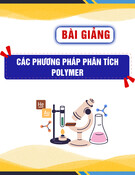
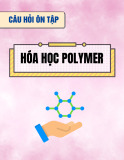

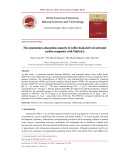
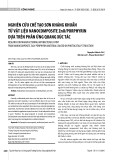
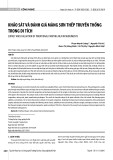
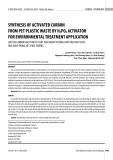
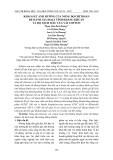

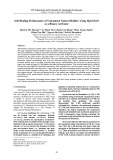



![Tài liệu học tập Chuyên đề tế bào [mới nhất]](https://cdn.tailieu.vn/images/document/thumbnail/2025/20250906/huutuan0/135x160/56151757299182.jpg)
